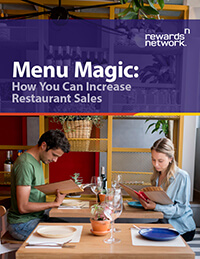Your restaurant menu is likely the first (and most lasting) impression customers have of your business, but that’s not all it needs to do. Ask yourself:
Can my menu help increase my restaurant sales?
In our newest report, we walk through four big factors that can help you decide whether your restaurant menu design is a big success or holding you back:
- Restaurant menu design
- Pricing of individual dishes
- Overall menu size
- Seasonality of offerings
Download this free eBook today to see if your menu is working as hard as it can to increase your sales.
Excerpt from Chapter 1:
If there’s one thing we’ve learned over the years in the food industry, it’s that every menu is some restaurateur’s baby. That can be a problem. Yes, your menu is the heart and soul of what a chef and owner want to put out into the world, but your menu is also key to ensuring you make money when you do. This dual reality can sometimes be difficult to reconcile.
Many restaurateurs express an emotional connection to every item listed on their menu, but at the end of the day, when everything is special, nothing is. It’s important to recognize opportunities for bigger profit, and identify ways to structure your menu not just to attract new customers, but to keep those customers coming back for more — again and again.
Know what you have.
Before you work on revising your menu layout, it’s important to conduct the cost audit we referenced briefly in the introduction. It is the only way to truly understand how every single item on your menu actually works for you in terms of profit and popularity. Once your analysis is complete, you’ll likely find some dishes from all four categories of items: Plow horse, star, dog, and puzzle.
Plow horse: low profit, high popularity
This could be your soup and salad lunch special, a one topping pizza, or that draft beer that seems to pull people in after work day after day. The plow horses are items that you probably sell a whole lot of, because they are priced with sensitivity to consumers who aren’t looking to spend a lot in one sitting but then inevitably become frequent, repeat customers as a result. Try to keep plow horses available and stable in price for as long as possible to keep pulling those repeat customers in.
Star: high profit, high popularity
These are the items that may be unique to your establishment, maybe even a dish your restaurant is known for. You can increase the price (within reason), and people will still buy them. Why? Because they can’t get them anywhere else. This could be a version of a popular dish made with higher quality or more unique ingredients — like pork belly dim sum — or a dish that very few restaurants have on their menus — like poutine or roasted chicken.
Dog: Low profit, low popularity
These menu items take up space that could be allocated to more profitable items, and when they are ordered, they can reduce sales of your stars and puzzles – your more profitable offerings. Try to get dogs off your menu, as fast as possible. If for some reason, you absolutely must keep them on, add $1 or $2 to the price. Make them worth your while.
Puzzle: High profit, low popularity
These are those dishes that should sell better, but aren’t. The reasons for that can be a real mystery to you. Don’t take them off the menu. Just try to figure out how to sell more of them. Maybe take the price down a little, or give them better placement on your menu. If you play around with the recipes, remember not to damage their profitability, but only do things that will make the dishes sell better.
Puzzles are likely to benefit most from the following ideas for making your menu more profitable and attractive to repeat customers.
Spotlight your stars.
Displaying a signature spotlight on your menu is a great way to drive interest to a particular item that’s “highly recommended by our chef” (or accountants). Box that dish in to make it stand out among the others. This technique draws the eye in and can make the work of scanning a menu less arduous for the diners’ weary eyes. But like anything else, the more you use this trick, the less it means. Limit your spotlight items to one per menu category.
Occasionally, restaurants will also feature decoys — items that would so rarely get ordered that it seems silly to leave them on the menu, like a 72oz steak or a banana split with 12 kinds of ice cream served in a kitchen sink. So why feature them? Because these types of extreme menu offerings can get your customers’ brain moving. You might not order a steak as big as your head, but just reading about it might put you in the mood for a much more reasonably priced (and profitable) 20oz Prime Rib.
Draw customers in.
Yes, keeping your menu clean and easy to read means eliminating distractions. But like spotlight items, drawn graphics can help pull the customers’ eyes across your menu page when used sparingly.
